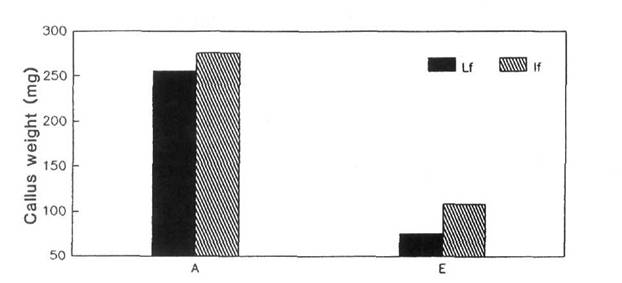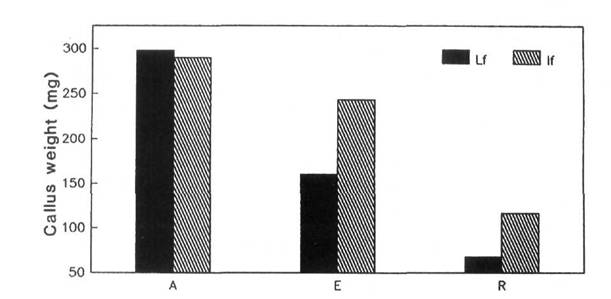
|
Pisum Genetics |
Volume 26 |
1994 |
Research Reports |
pages 13-15 |
Manifestation of the lf gene in callus cultures from different tissues of pea seedlings
|
Ezhova, T.A. and Efremova, O.V.
|
Department of Genetics Moscow State University Moscow 119899, Russia |
The lf gene operates in the shoot apex to determine the threshold level of flowering signal necessary to trigger flower initiation (4). Earlier we reported (1) on the influence of the lf gene on the growth of callus tissue induced from apices of pea seedlings. It was shown that higher levels of the synthetic auxin NAA (napthalene acetic acid) were needed in the culture medium to trigger optimum growth in Lf than lf callus. It was therefore of interest to find out whether the genotype at the lf locus would also influence the growth of callus cultures induced from other tissues of pea seedlings, e.g. stems or roots.
Material and Methods
Tissue cultures were induced from shoot apices, epicotyls and roots of pea seedlings of genotypes Lf and lf [lines regenerated from cv Ranny Zeleny (1)] using the Gamborg method (2). The influence of NAA content (0.2 or 1 mg/L) on callus weight was studied. The BA (benzyladenine) content was the same in all experiments (0.1 mg/L). The experiments and their statistical analysis were carried out as reported earlier (1).
For scanning electron microscopy (SEM) of callus cells, calluses were fixed in 4% glutaraldehyde in 0.16 M sodium phosphate buffer (pH 7.3-7.4) at 4�C for at least 12 h and dehydrated in a graded ethanol series. Calluses were then critical point dried using CO2.
Results and Discussion
Different tissues of pea seedlings required different auxin content for successful callus induction. Root tissues formed callus only on media with ≥1 mg/L NAA. Induction of callus from epicotyl tissues was observed in media with high (1 mg/L) as well as low (0.2 mg/L) NAA content. However, in the latter instance callus cultures grew slowly and showed some necrosis. Tissues from the apices of pea seedlings produced light-green rapidly growing callus in media with both high and low NAA content (Figs 1, 2). Obviously, such results can be explained by the different content of endogenous auxin in different parts of pea seedlings (3), as well as by different abilities of callus cultures induced from apices, epicotyls and roots to synthesize endogenous auxin. Some indirect indication of the lower ability for auxin production in callus cultures from roots was obtained via SEM examination of callus cells. It is known that auxins induce not only the activation of division, but elongation of cells as well (3). Callus cells induced from roots were of roundish shape and on average half to two-thirds the size of cells from apices and epicotyls.
Our research showed that the genotype at the lf locus considerably influenced the growth of callus. Callus cultures of genotype lf in a medium with 0.2 mg/L NAA grew better than Lf callus irrespective of the origin of the culture (Fig. 1) and we did not find a significant genotype x tissue interaction in this experiment (Table 1). In contrast, callus growth of genotypes Lf and lf in a medium with a high content of NAA depended upon the type of tissue used to induce the callus (genotype x tissue interaction statistically significant, P<0.001; Table 2). Callus of genotype Lf grew slightly better than lf callus when the callus was induced from apices (in this experiment the difference was not statistically significant) but in callus cultures induced from epicotyls and roots genotype lf grew better than Lf (P<0.01 and P<0.001, respectively; Fig. 2).
Table 1. Analysis of variance for callus weight (experiment with 0.2 mg/L NAA)
|
Source of variation |
d.f. |
Mean square |
F |
P |
|
Lf (Lf; lf) |
1 |
34054.9 |
13.09 |
<0.001 |
|
Tissue (Apex; Epicotyl) |
1 |
1576152.5 |
605.76 |
<0.001 |
|
Interaction (Lf x Tissue) |
1 |
2005.4 |
0.77 |
0.390 |
|
Residual |
209 |
|
|
|
Table 2. Analysis of variance for callus weight (experiment with 2 mg/L NAA)
|
Source of variation |
d.f. |
Mean square |
F |
P |
|
Lf (Lf; lf) |
1 |
33580.2 |
20.74 |
<0.001 |
|
Tissue (Apex; Epicotyl; Root) |
2 |
248525.3 |
153.49 |
<0.001 |
|
Interaction (Lf x Tissue) |
2 |
13601.7 |
8.40 |
<0.001 |
|
Residual |
70 |
1619.2 |
|
|

Fig. 1. The growth of Lf and lf callus induced from apices (A) and epicotyls (E) on a medium with 0.2 mg/L NAA.

Fig. 2. The growth of Lf and lf callus induced from apices (A), epicotyls (E) and roots (R) on a medium with 1 mg/L NAA.
Earlier it was shown that callus induced from apices of genotype Lf grew better than callus of genotype lf on media with high (1-2 mg/L) NAA content whereas on media with low NAA content genotype lf grew better (1). It can be supposed that in callus cultures induced from epicotyls and roots the total auxin content (exogenous plus endogenous) in 1 mg/L NAA medium is sufficient for intensive callus proliferation of genotype lf, but is not enough for similarly intensive growth of Lf callus.
Thus, our experiment proved that the difference between isogenic Lf and lf lines can be observed not only in callus obtained from apices, but also in callus induced from epicotyls and roots. It can be assumed that the cell differentiation during callus initiation can induce expression of the lf gene whereas expression of this gene is spatially and temporally specific at the whole plant level.
Acknowledgement. This work was partly supported by a grant from the Russian State Program Frontiers in Genetics.
Ezhova, T.A. and Kovalenko, O.V. 1992. Pisum Genetics 24:40-43.
Gamborg, O.L., Constabel, F. and Shyluk, J.P. 1974. Physiol. Plant 30:125-128.
Moore,
T.C. 1989. Biochemistry and Physiology of Plant Hormones. Springer,
New York, 330 pp.
Murfet, I.C. 1985. In: Halevy, A.H.
ed., Handbook of Flowering Vol. 4, CRC
Press, Boca Raton, pp. 97-126.